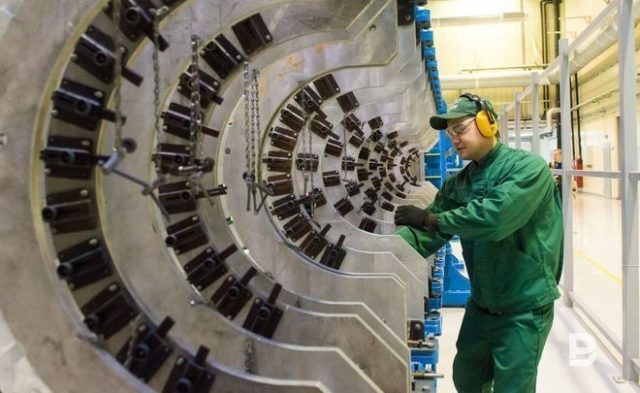
The Influence of the Pandemic on Russia’s Defense Industry
Publication: Eurasia Daily Monitor Volume: 17 Issue: 110
By:

The COVID-19 pandemic has plunged the world into a recession and damaged global supply chains. Russia’s defense industry has not been immune to these disruptive processes, and it came under government-mandated lockdowns between March and June 2020. The shutdowns have already created delays in weapons supplies to the Russian Armed Forces, and those gaps in arms procurement have, in turn, negatively impacted revenues coming into the defense-industrial sector. Many of Russia’s defense companies have tried to blame the pandemic for their own manufacturing failures. But even where such attribution is justified, the main coronavirus-related problems faced by the arms manufacturing sector are actually less direct, caused by inevitable deficits in the state budget and the devaluation of the Russian currency. These economic challenges not only leave the defense industry more vulnerable financially but are also likely to, over the long term, force Russian arms manufacturers to become increasingly insulated from the global market.
Supplies of weapons to the Russian Armed Forces were apparently delayed during the first half of 2020. Unlike in previous years, the Ministry of Defense did not report accepting any military products in March–April or (to date) in July 2020. According to a procedure established in 2014, the defense minister reports twice or thrice a year on how many weapons were supplied by the defense industry to the Russian military (Kremlin.ru, March 11, 2016). The postponement of the ministerial report does not necessarily mean no arms or equipment were supplied at all, but it does suggest there was some sort of trouble associated with the latest procurements.
Notably, certain defense-manufacturing facilities, like the Kazan Optical-Mechanical Plant, were shuttered completely during April 2020 (Realnoe Vremya, April 7, 2020). Other factories, such as those belonging to Russian Helicopters and the Reshetnev Company, worked at only partial capacity (30–80 percent of employees) during the hardest phase of the COVID-19 lockdown in April–May (Kremlin.ru, April 9; Iss-reshetnev.ru, May 29). The pandemic-related work stoppages impacted mainly supply chains between Russia’s main arms contractors and their domestic subcontractors—a challenge that President Vladimir Putin devoted personal attention to try to resolve (Kremlin.ru, April 9).
That said, the situation has laid bare another serious systemic problem. Namely, the pandemic has disrupted the Russian defense industry’s ability to execute export arms contracts, which have both crucial economic as well as political significance for Russia. In the first quarter of 2020, Russia’s weapons sales abroad decreased by 36 percent due to local outbreaks of the coronavirus (RBC, June 9). The situation did not really improve in the second quarter, as the spreading pandemic forced global lockdowns. As a result, for the rest of the year, domestic arms producers are likely to prioritize fulfilling outstanding export orders—particularly since Russia’s main defense customer, India, has been putting pressure on the former to speed up deliveries (Kommersant, June 26). But this focus on foreign markets will inevitably lead to further delays in arms supplies to the Russian military.
The political dimension of these delays manifests itself as tension between the government and the defense companies over two crucial issues. First is the question of payments for delayed supplies. The state-owned defense industry needs money even if it is not able to meet contractual schedules; but any consequential delays in payments from the state will only further exacerbate production problems. Second is the question of just how many failures in domestic arms manufacturing can, in fact, be attributed to the pandemic and associated work stoppages. The first of these state-versus-industry disputes is being resolved with a compromise—the government is paying defense firms on time, as of July 2020 (Ministry of Finance, July 15, 2020), but with an option to cut spending for delayed arms procurements by 5 percent in 2021–2023 (RBC, July 20). However, the second issue does not have easy solution, because Putin fears the Kremlin’s control over the defense industry will erode if the pandemic is exploited to excuse too many failures (Kremlin.ru, April 10).
The pandemic became a trigger for an economic recession but carries longer-term consequences for the domestic military-industrial sector. The devaluation of Russia’s currency has meant that $1 costs approximately (and sometimes more than) 70 rubles in July 2020. For comparison, the average exchange rate was 64.66 rubles per $1 in 2019. The previous highest average exchange rate, 67.19 rubles per $1, occurred in 2016; that year, the Russian government was forced to spend an additional $11.9 billion to balance the domestic defense industry’s books (RIA Novosti, October 17, 2016). Despite Russia having adopted an import-substitution policy in response to Western sanctions on the country, its arms producers continue to rely on various manufacturing equipment and components (especially electronics) from abroad. The devaluation of the ruble, thus, creates additional difficulties for supply purchases.
Even if Moscow decreases outlays for arms procurements by 5 percent in 2021–2023, as proposed by the finance ministry (see above), the government will nonetheless still need to bail out its troubled state-owned defense companies because the latter lack financial sources to remain solvent. The alternative would be for the government to increase investment in R&D, pursue new import-substitution programs, as well as allow the defense sector to tackle more profitable civilian manufacturing projects. However, Russia’s defense companies notably lack competitiveness even in the domestic civilian market and would need significant protectionist measures to compete with foreign manufacturers. Therefore, one of the most probable long-term scenarios for Russia after the pandemic will be the adoption of policies of further economic self-isolation. And the defense industry will certainly help drive this trend.



